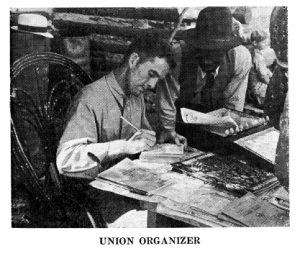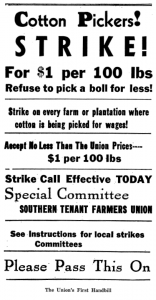“May America never forget that as long as festers of substandard working conditions, extreme poverty, helpless insecurity and racial discrimination exist within our borders, our beloved land fails of its great promise.” –Paul H. Douglas, U.S. Senator, Illinois; Foreword, Workers in Our Fields: The Story of a Union That Would Not Die, PAM 3566, UCA Archives.
Every February the celebration of Black History Month commences; however, the contributions of black Americans should be celebrated regardless of the month.
This From the Archives segment highlights the contributions of black Arkansans to the fight for fair working conditions within the agricultural sector, manifested in the Southern Tenant Farmers’ Union–STFU.
The organization began south of Tyronza, Arkansas in July of 1934. Eighteen white and black men met in Sunnyside schoolhouse to discuss the unionization of agricultural workers. New Deal financial aid failed to reach many tenant farmers, also known as sharecroppers, due to landlords retaining the bulk of the benefits. The financial assistance was distributed with the intention that landlords would retain the same number of tenant farmers despite land reduction, and land removed from production was to be redistributed to tenants for personal food production. Despite the hopes of the New Deal assistance, many landowners withheld aid and instead attempted to drive tenants from the land.
Fairview Plantation’s owner, Hiram Norcross ignored the protections the New Deal program afforded tenant farmers, and he evicted them from the land, ending the leases. As a result local tenant farmers organized with the intent of forming a union.
The men discussed options for the structure of the organization, adopting the suggestion that the union be made a legal organization and operations fully transparent. The farmers also discussed whether there should be one organization or two separate organizations on the basis of race.
“…An old man with cotton-white hair overhanging an ebony face, rose to his feet…He had been a member of a black man’s union in Elaine, Arkansas. He had seen the union with its membership wiped out in the bloody Elaine Massacre of 1919. “We colored people can’t organize without you…and you white folks can’t organize without us.”
On July 26, 1934, the farmers received a certificate of incorporation from White County for the Southern Tenant Farmers’ Union. One integrated union, and a tenuous allyship.
The STFU held meetings in local churches, schoolhouses, and private homes. A key characteristic of the STFU meetings were the cultural contributions of the black members in attendance. Each meeting opened with prayer and singing from spirituals. Religious fervor, Biblical quotes, and Populist movement sayings were all used in STFU slogans printed on banners, pamphlets, and signs and adopted as part of the Union’s mission statement.
“Many of them are songs of protest which grew out of conditions existing before slavery was abolished.”
The official Union song, “We Shall Not Be Moved” received a minor editorial with the inclusion of the words, “Just like a tree planted by the water, we shall not be moved. The Union is a’marching, we shall not be moved.”
Despite the peaceful nature of the STFU meetings, members often faced difficulty in holding them for extended amounts of time without interference from local plantation owners, and in some instances local law enforcement. Churches where the meetings took place were padlocked and boarded up, and the school houses were filled with hay preventing future meetings. When the destruction of locales failed to deter the Union, vigilante violence occurred culminating in March, 1935–a reign of terror.
The “reign of terror” attempted to permanently end the Union by a variety of means including: banning meetings; falsely accusing, arresting, and jailing members; convicting members on trumped up charges; withholding relief benefits; evicting tenant farmers from the land; burning churches; machine gunning houses; stuffing school houses with hay; mob violence resulting in murder.

Though their lives were threatened, the STFU members continued with meetings and organized a cotton strike to raise wages from sixty-five cents per one hundred pounds to one dollar per one hundred pounds. A State Department labor official reported that within the delta region, he saw only two workers picking cotton during the height and success of the strike.
All research and images come from: Workers in Our Fields: The Story of a Union That Would Not Die, PAM-3566, University of Central Arkansas Archives, Conway, Arkansas, USA.
Author: Shelbea Gentry
Editor: Daniel Klotz






